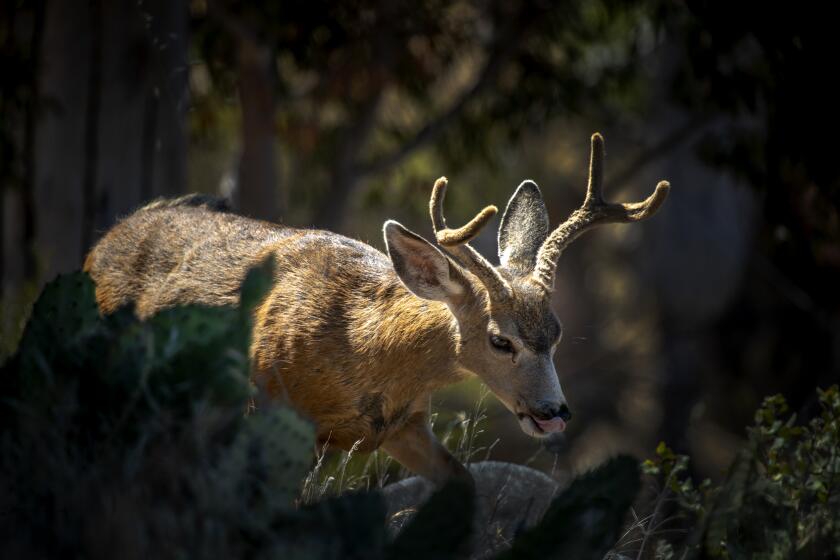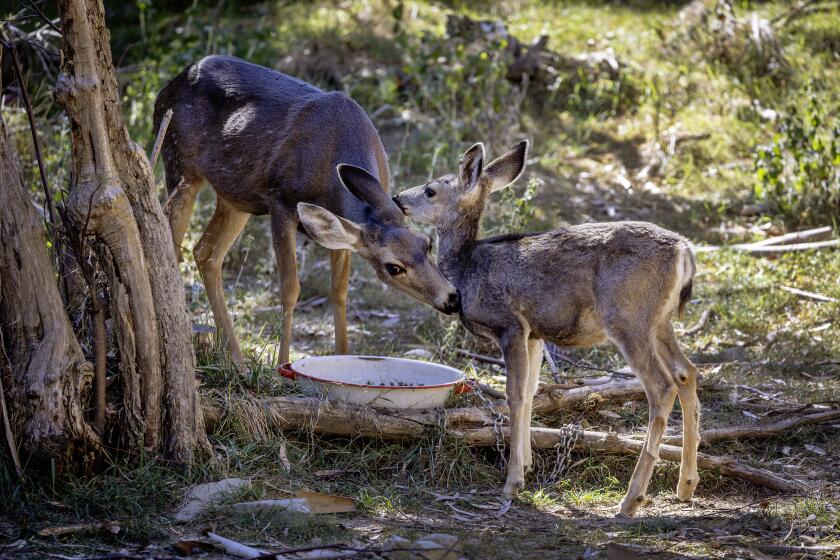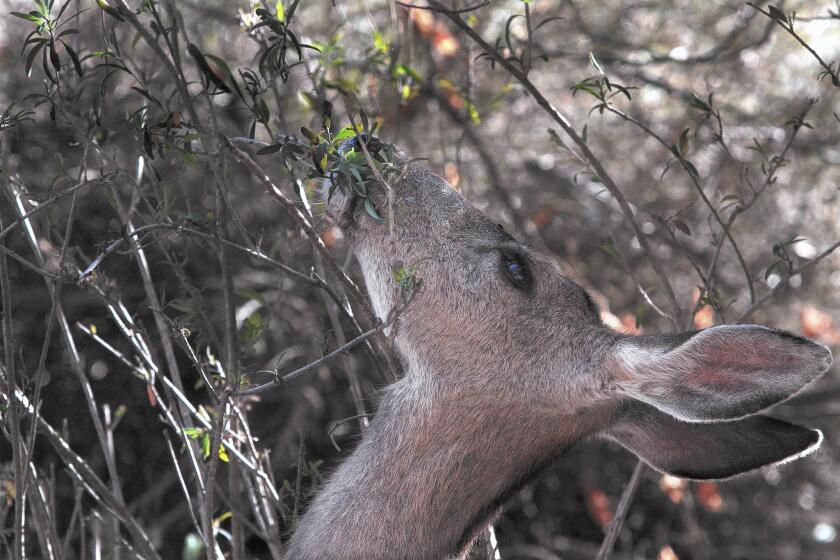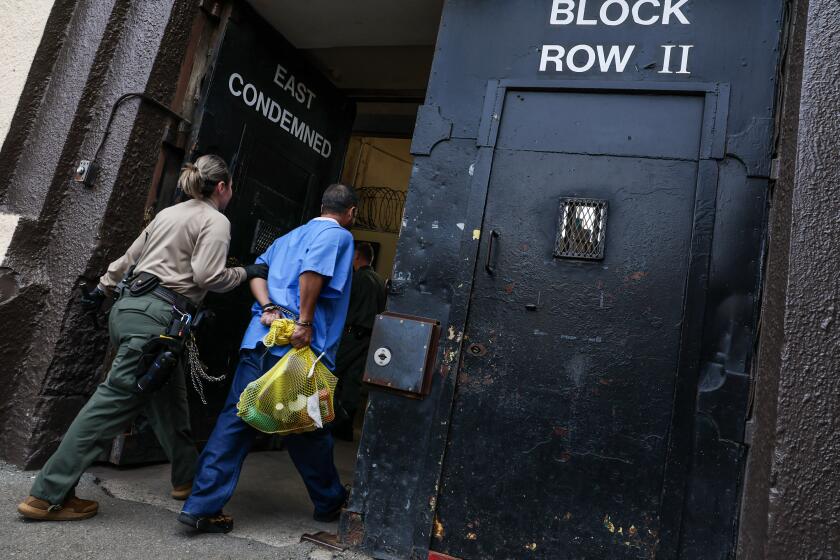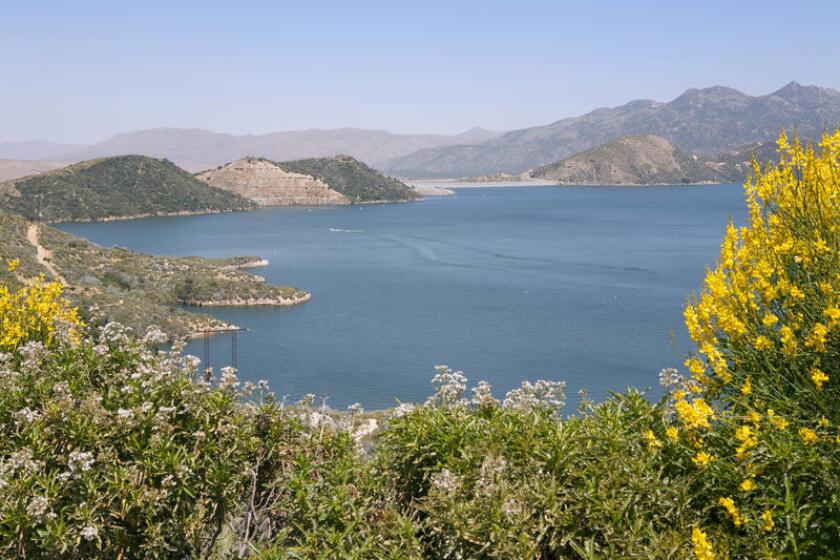L.A. supervisors oppose plan to eradicate Catalina deer by shooting them from helicopters

In the fall, the Catalina Island Conservancy labeled its plan to eliminate the island’s invasive mule deer population, by employing helicopter-bound hunters armed with high-powered rifles, “bold and ambitious.”
But the Los Angeles County Board of Supervisors chose other descriptors, decrying the proposal in an opposition letter as “inhumane and drastic.”
Supervisor Janice Hahn, whose district includes Santa Catalina Island, drafted the response — saying she was prompted by “an intense public outcry” that sprung up after the aerial sharpshooting proposal became public.
The nonnative mule deer population on the island can range between 500 and 1,800, according to the conservancy. The deer have destroyed natural habitat — including native vegetation found only on the island — and exacerbated the risk of soil erosion in grazed-over areas.
As this is happening, the deer are starving and dying of thirst .
“The island and the deer are both fighting for survival and neither one is winning,” Whitney Latorre, the conservancy’s chief executive, said in an interview with The Times in the fall. “Unless we address the deer issue, the island will become more and more vulnerable to the devastating consequences brought on by rising temperatures and drought.”
Invasive mule deer are pushing native plants to the brink on Catalina Island. Officials want to hunt animals from helicopters.
Hahn, however, called for the conservancy to reconsider other options it previously studied and rejected. The conservancy manages nearly 90% of the island.
A Hahn spokesperson said the supervisor did not have a preference for a specific alternative, but asked the group to reconsider sterilization, relocation or extending the hunting season.
The Board of Supervisors on Tuesday voted unanimously to send a letter expressing its opposition of the plan to the California Department of Fish and Wildlife. The agency has the authority to approve or deny a permit application initially filed by the conservancy in August 2023 to remove the deer.
An agency spokesperson confirmed that the permit, if approved, would allow the conservancy to “remove non-native, invasive, or detrimental wildlife to improve or restore ecosystem or habitat conditions.”
Catalina Island Conservancy and residents near compromise over deer eradication proposal
Normally, the review process takes 100 days, said Fish and Wildlife spokesperson Tim Daly. However, Daly said the department hasn’t ruled on the application because it’s been waiting for the conservancy to file additional requested paperwork.
The conservancy did not respond to calls for comment.
The conservancy previously said it planned to hire sharpshooters from the Connecticut-based nonprofit White Buffalo Inc. The group would use AR-15-style rifles with lead-free bullets, to avoid poisoning natural scavengers.
Some carcasses would remain where they fall and those closer to Avalon and roadsides would be removed.
Mule deer were introduced to the island in the 1930s as a game species for hunting, according to the conservancy.
The conservancy reviewed six potential plans for deer removal, including fencing, aerial sharpshooting, recreational hunting, the introduction of natural predators, relocation and sterilization as well as the use of chemical contraceptives.
Each option was evaluated on seven factors, including minimizing the effect on ecology and deer’s suffering, team safety and how quickly it could be accomplished.
Grades ranged from poor to excellent. Aerial sharpshooting was the only option that earned at least a “good” grade on the seven values, with fencing and hunting earning four “fair” designations or higher.
Aerial sharpshooting was listed as the top option because it’s “efficient” for eliminating large numbers of deer over a short amount of time, according to the conservancy.
The main drawbacks included the loud sounds of gunfire, which could distress wildlife and local residents.
In a conservation battle that pits native vegetation against imported deer, Catalina Island residents say they’ll take venison over ‘stupid plants’ any day.
In comparison, fencing was described as costly and challenging given the island’s topography, while recreational hunting was generally ineffective on its own, the conservancy found.
However, opposition to aerial hunting has grown over the months.
The advocacy group Coalition to Save Catalina Island Deer has collected more than 18,000 signatures since Sept. 23 on a petition opposing the concept.
The group says there was “no meaningful public process” in discussing the proposal and characterized aerial shooting as “inhumane tactics.” Both the coalition and Hahn have said the sharpshooting method is extreme.
The conservancy hosted a community forum Jan. 31, after the petition was published, to discuss several conservation issues, including the deer population.
However, the idea is not a novel one, said Bernd Blossey, a natural resources and environment professor at Cornell University.
Blossey, who also is chair of the university’s deer management program, pointed to aerial shooting efforts used to eradicate feral goats on the Galapagos Islands and in New Zealand earlier this century.
Over the last two decades, the conservancy that owns nine-tenths of this island has shot, trapped and shipped out thousands of goats, pigs and bison that were literally eating away the island.
“When people ask if something is normal, I respond with, ‘How do you define normal?’” Blossey said. “In the case of Catalina, which is an island like the Galapagos and New Zealand, using helicopters or aircraft to shoot unwanted animals is standard operating procedure.”
Blossey also believes that calls to relocate the animals, as some conservationists want, may be more harmful than helpful.
“The capture is traumatic, the transport is traumatic, and the success rates of doing both are poor,” he said. “Then they’re moved to areas that they don’t know and it’s just not a good thing.”
Blossey also said he didn’t want to “sugarcoat” aerial shooting, because he said the mortality numbers would be high, particularly early in the process.
“You might get a couple hundred in the first week because the deer aren’t used to the tactic and won’t have any defenses,” he said.
If approved, the hunts would begin in the fall.
More to Read
Start your day right
Sign up for Essential California for news, features and recommendations from the L.A. Times and beyond in your inbox six days a week.
You may occasionally receive promotional content from the Los Angeles Times.
